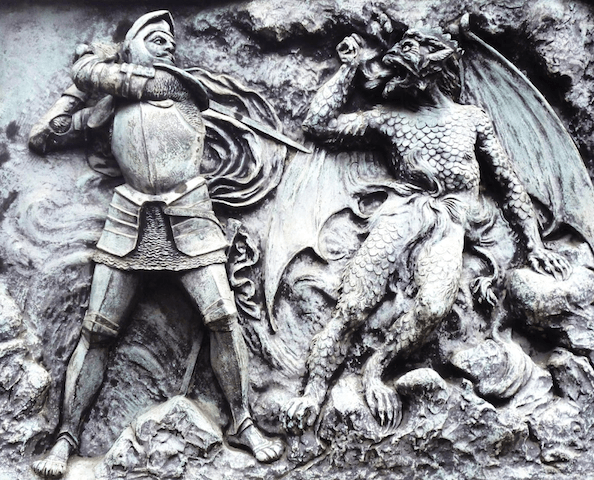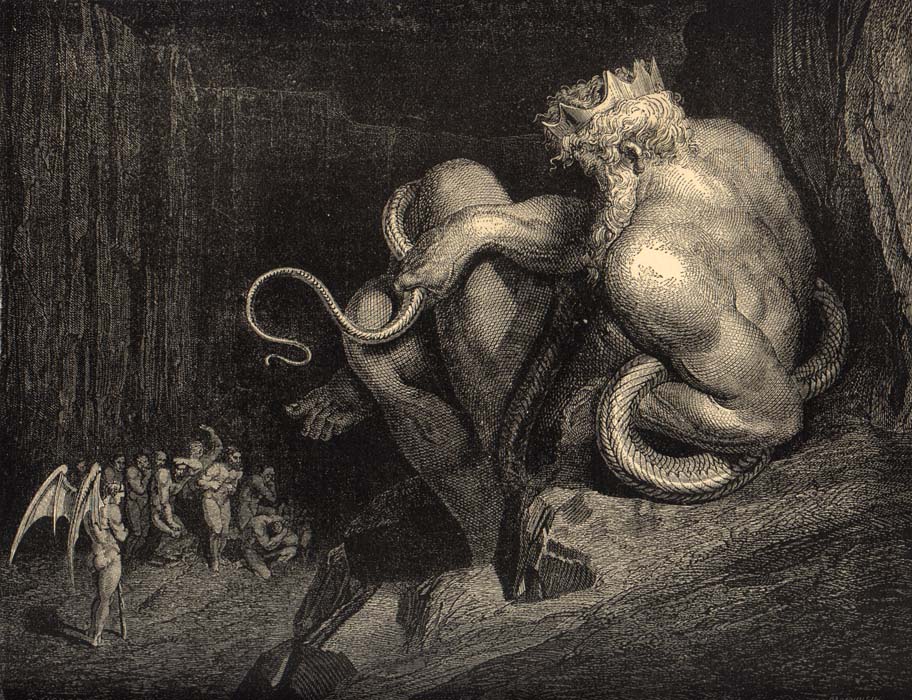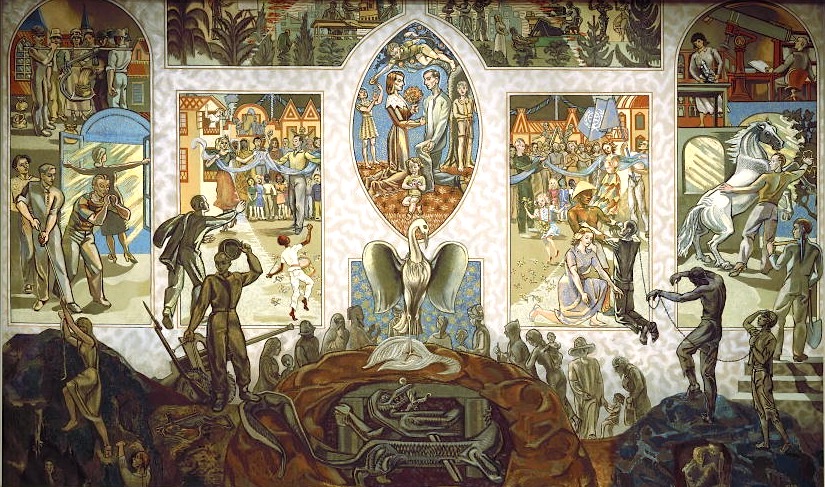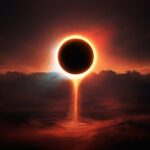In Revelation 9:11, it is said, “the angel of the bottomless pit, whose name in the Hebrew tongue is Abaddon ( Abbaton), but in the Greek tongue hath his name Apollyon and in the Vulgate by the Latin Exterminans (Destroyer). We are told he is the king of the deep pit which is is the great gathering place of the dead, more commonly known as Sheol ie: hell or the abyss and the name given to the angel who with Maweth, i.e. ‘death,’ stands over the six angels of destruction, who aid God in the punishment of the wicked.

As the power of the prince of the air, he represents God’s prosecuting angel coming out of the bottomless pit on the Judgment Day. It is at the sound of the fifth trumpet, Apollyon of Revelation has the dominion over the plague of locusts resembling horses with crowned human faces, women’s hair, lions’ teeth, wings, iron breast-plates, and a tail with a scorpion’s stinger that torments for five months anyone who does not have the seal of God on their foreheads.
In ancient Gnostic texts such as in the 3rd century Acts of Thomas, Abaddon is the name of a demon, or the devil himself. The two texts that explain his roles is a homily called “The Enthronement of Abbaton” by pseudo-Timothy of Alexandria, and the Apocalypse of Bartholomew.
In the homily by Timothy, Abbadon was first named Muriel, and had been given the task by God of collecting the earth that would be used in the creation of Adam. Upon completion of this task, the demon/angel was appointed as a guardian over the spiritual and corporeal realms which includes the angels, demons, and corporeal entities who greatly feared him.
Muriel (angel) Muriel, whose name is derived from the Greek myrrh, is a Domination or Dominion (one of the ‘Second Sphere’ Angels) in Western Christian Angelology. Muriel is the Angel of the Month of June, is associated with the astrological sign of cancer, and is invoked from the South.
Abaddon was promised that any who venerated him in life could be saved. Abaddon is also said to have a prominent role in the Last Judgement, as the one who will take the souls to the Valley of Josaphat. He is described in the Apocalypse of Bartholomew as being present in the Tomb of Jesus at the moment of his resurrection.
It’s interesting to note that Apollyon the Destroyer is called the King of Hell and is appointed as the “official guardian” over all angels, demons, and humans and was also present with Jesus at the moment of his resurrection. This shows that he is the most powerful angels in all Christendom who happens to be the leader of the Gnostic and whose power was of divine origin.
The early Church Fathers ascribe to the Gnostic doctrines as a prevailing heresy and pestilential swarm of locusts ie: Gnostics who rule the pit of the bottomless deep,” and likewise with the name of its leader, Apollyon, (Hist. Eccl. lib. iv. c. 7.) who represents this attack as a warlike invasion, calling its leader iroXtfiutraTOq, and with the alarm sounded by the trumpet. Justin Martyr is also represented by the same historian as ascribing this invasion to a diabolical operation. (lib. iii. c. 26.)
Eusebius ascribes the rise and progress of the Gnostic heresies to some serpent-like power; and compares their latent mischief to that of a lurking reptile, (lib. iv. 7.) And Tertullian, in his treatise entitled Scorpiace, (that is, antidote against the scorpions,) directly compares the Valentinians and other Gnostic teachers to scorpions, instancing the points of resemblance in the dangerous poison of a little contemptible animal; in their infinite kinds and varieties, all armed in the same manner with a tail, and produced by heat.
Jacob Brucker, who, in his Critical History of Philosophy, after speaking of a sect of oriental philosophers in the first century, adds: “and when many from that sect had betaken themselves to the Christian religion, and had preposterously attempted to unite their precepts to it,—hence there arose those swarms of heresies, which, priding themselves in the name of Gnostics, like winged insects, went lying throughout all the Churches of Asia and Africa, and contaminated the simplicity of the most holy religion with the most absurd nonsense; and continuing their progress to the Jews also, and even to the Gentiles, miserably corrupted the national philosophy of both these; invented wild and monstrous notions, confirmed and increased the wide-reigning fanaticism, disseminated multitudes of spurious books, and corrupted the whole world with the very worst doctrines.” 1
Looking further into the etymology of the king of hell, I found that the Hebrew (Phoenician) word for the English Apollo is Abdun and is spelled normally today Abaddon (Abba-Don or Oub-adon) which would read in Hebrew as “abdun— place of destruction, abyss,” citing Prov. 27:20 and in the Hebrew Job. 28:22, abdun — place of destruction, and mut or Môt which is the Semitic word for ‘Death.’
Interestingly, I discovered in The Theology of the Phoenicians from Sanchoniatho, it says “Môt also means ‘mud’ which some call Ilus (Mud), but others the putrefaction of a watery mixture.
And from this sprung all the seed of the creation, and the generation of the universe.”
I have also found that Abaddon is compounded of the two words, Abba meaning Father/Papa/Leader, and Don/Dan, which means “Lord/Master/Chief.” This is why the Savior who was a Jew (Phoenician) told his people, the Jews (Phoenicians);
“Ye are of your Father, the Devil.”
The Christian angel of the bottomless pit who is known as the antichrist is actually the same angel of the people who had carved in stone on their temples, “Know Thyself” and “Nothing in Excess” – The Gnostics who we also know anciently as The Pythia Priesthood of the Delphic Oracles.
A historical man connected to this history was a Samaritan named Simon Magus who was also called by the early Church Fathers as the First Gnostic and also by the surname of Satan. The word Satan is derived from the ancient Greek Σατάν (Satán) and the Hebrew שָׂטָן (Sātān) which means “adversary, the accuser, to show enmity to, oppose, plot against,” from root s-t-n “one who opposes, or obstructs.”
We know of Simon’s AKA Satan’s adversarial followers as the Gnostics were called the “Sons of Satan.” Let me add that another surname for Simon was Peter – a name that means Father and or Cock.
Their historical home is the Holy Island of Crete at the City of Gnosis – Knossos and Holy Mountain – Mount Ida, which is the original ancient Home of the Judeans – Tribe of Judah near of all places, Samaria Gorge.
This is the same locale I have identified as one of the homes of Apollo. In Homer’s Iliad in the Hymn to Apollo, which Apollo himself is introduced conducting a band of Cretans, who came from the city of Knossos where he chose his first priests, whom he selected in their “swift ship” were “Cretans from Minos’ city of Knossos (Gnosis)” who were voyaging to sandy Pylos. In the Delphi Complete Works of Diodorus Siculus, he had written that Apollo has been called Delian and Lycian and Pythian, and Artemis has been called Ephesian and Cretan and Tauropolian and Persian, although both of them were born in Crete.
Crete also happens to be the home of “Pergamom – Where Satan’s throne is.” (Revelation 2:12) This was the ancient Cretan city of Pergamon (Pergamum), and home to one of the seven churches written about by Saint John in the Book of Revelation. It was the original uncorrupted church (Gnostic) of Christ that later became the seat the of Antichrist or Throne of Satan and the official home of Apollo AKA Apollyon, the Delphic Oracles and his Pythia Clergy of the Bottomless Pit.
The name Pythia is derived from Pytho, which is derived from púthein – meaning “to rot”, and is said refers to the sickly smell of the decomposition of the body of the monstrous Python after she was slain by Apollo.
After Apollo’s victory over the serpent ie: the devil and its rotting body were brought into subjugation in the pit, we can safely say that Apollo became the angel of the bottomless pit. For that reason, Apollo is the Destroyer of chaos and evil ie: Modernity and the Chief Supreme Court Judge of the humans who worship the devilish creation ie: The Golden Calf in which his arrows smite these people to the place of judgment and purgatory, the abode of the souls of the dead ie: Hell where they belong.
This is why we find Apollo often symbolically represented holding sometimes a harp, and a shield, and his bow and arrows; to signify his threefold power on earth where he is named Liber Pater, in heaven, where he is called Sol (Second Sun), and in hell, where he is styled Apollo (Apollyon). Let me add that not surprisingly, the harp and bow are both ancient national symbols for Crete and some of their other nations they founded such as Ireland.
If you have been looking for the Gnostic Archons, they have been around since time immemorial.
Apollo’s harp does not represent music per say, but harmony in government (temporal and spiritual ie: the marriage of church and state) which brings true law and order as he uses his bow and arrow to rightfully punish the sinning creatures (locusts) of the earth ie: people/fallen angels/apostates.
This is how the Masons help bring ORDO AB CHAO and the high degrees of Freemasonry mention Appolyon – their Masonic Grand Master.
In the West, we Roman Catholic Christians call the Vicar of Christ – AKA the Pope also by the name of the “Father or Holy Father” and in Latin countries as Papa who sits in the chair of Liber Pater AKA Saint Peter who was the first Pontifex Maximus. Here in the U.S.A., we have the PONTUS.
Over in the East and in the North, Orthodox Christians have their Patriarchs who are the male heads/fathers of their spiritual families (race/kin). The word is taken from the Greek patriarkhēs, from patria ‘family’ + arkhes/archein/archon – meaning “to rule.” The head Archon of 300 million Christians in the East is The Ecumenical Patriarchate of Constantinople – Patriarch Bartholomew and the leader of the autocephalous or independent Orthodox Church is Patriarch Kirill – “Patriarch of Moscow and All Russia.”
Hence, as Virgil had said, “Here comes the Virgin’s and Apollo’s reign.”

Moe is the founder of GnosticWarrior.com. He is a father, husband, author, martial arts black belt, and an expert in Gnosticism, the occult, and esotericism.





Sry for my english. amazing gnosis. You must be gnostic warrior 😛
Thank you
See also: Apulu. Referring to the spirit its self and its house (i.e its spiritual descendants) like nergal, scylla (terror of the deep), asmodeus (who was once a cambion before turning into a demon entirely, buried alive in the desert by raphael (one of few ways to kill an arch-cambion??) after asmodeus stole king solomans kingdom. And then myself, the 4th spiritual offspring and 3rd prince. Nergal is a dark deity. Scylla is– a divine monster lets be honest. Asmodeus, a demon king. And i am a demon deity(?) Arch-cambion, purified and deified by the spark of creation within, kundalini. Full illumination and spiritual rebirth. Though, it is not totally complete until i leave this body. Though… my true self (?) cosmic lightning and fire guy. (???) exist outside of space and time. Considering i was an unknown to an all knowing being, that’s a bit of confirmation. Being insanely—sane. Is both the ultimate curse and greatest relief. Maybe its the fact that i actually pissed off the “GOD”… THE ONE. Just so i could demand they destroy me entirely. Still, even if it was creepy as hell. I would think they would want to.
Lol ,apollo is also the eyptian horus ,he is mithra too his animal totemn is the wolf , his twin artemis is Dianna the huntress ,Baalat , horus is the risen osiris or the incarnation of osiris . Osiris is kartekaya dyonisis murugan in hinduism . When horus unites with the fire of the sun he is solar lunar , hence the golden aura or the suns rays around his head . Osiris,s ka goes into horus hence the new man , the bull horus representing strength . The egyptian trinity is the same as the sumerian one . The moon sin , innana and the sun . Osiris represents mars and his two wifes psyche ,to blow the ka and venus . Its like the chakras from the neck down . Its like the star of islam ,alat , ( balat) aluzu ( venus) and manat ( kali ) who decrees the fates . Kali is ershigal like the egyptian set . So horus is connected to osiris , then he becomes the bull always associated with the earth or the moon , then solar lunar . There is a link with horus and hubal or the moon god sin and baal. Apollo mithra is the 6th grade of mithraism . The lions grade due to the solar association . Remember apollo is associated with the wolf . So is Diana 5th grade in mithraism . I think youll find saturn death at the top . The sumrian Anu is cronos saturn , enlil baal is his son , and enki , half man half fish the five pointed star is murugan , dyonisis. Apollo is mithra . The Roman pope sits at this grade . The biblical el shaddi is cronos , the egyptian sets totem animal is a jakal, so is anubises and so is the sumerian anus . The adoni in the bible is Tammuz Adoni is the phonecian name for Tammuz. Tammuz is horus . The head of the phonecians was el or elshaddi . The phonecians worshipped baal , and theres is evidence that the phonecians were hyksos . The name adolf means noble wolf the wolf is associated with apollo and dianna , the wolf is associated with the arians who view themselves as nobles . The egyptian claimed the hyksos worshipped set . Serapis is oris apis and serapis .
So, if what you say is true, please simply explain what all these allegorical stories mean in plain English? Also, try summing up the information succinctly in a sentence or 2 that you have gathered over many nations and centuries with what this all means so I can truly see if you understand that which you read, write, and I assume, purport to understand.
Something tells me you have no idea what you are talking about and are just repeating things you have read bu other authors rather than processing the information in your own mind and thus making sense out of the nonsense you write or rather regurgitate.